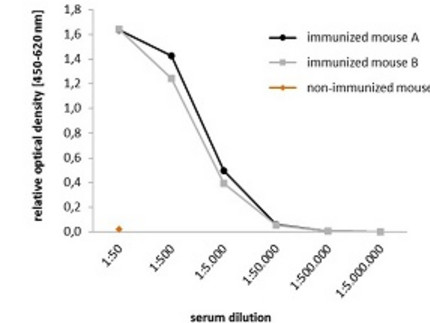Development of an antibody platform
The Induction of Immune Responses
A necessary precondition for the production of monoclonal antibodies is the induction of an immune response in the experimental animal or in vitro. But not every substance is able to induce such an immune response. Depending on the nature of the substance, there are more or less immunogenic properties. Within the scope of PIT, techniques will be further developed to facilitate the induction of immune responses against low immunogenic substances such as peptides or haptens. For this purpose, a chimeric viral carrier has been developed which is able to induce specific immune responses within 4 weeks.
Virus-like Particles
Virus-like particles are non-infectious, but their structural and immunological properties are scarcely different from those of real viruses and therefore, as compared to conventional antigens, produce strong immune responses.
Low immunogenic peptides can be combined with the viral envelope protein by cloning the corresponding DNA sequences. Furthermore, the virus-like particles required for the immunization are expressed in E. coli and purified. This results in chimeric virus-like particles which are capable of triggering an immune response against the normally low immunogenic peptide. The use of chimeric virus-like particles allows the induction of a very fast and specific immune response, which can even dispense the addition of adjuvants.
Moreover, immunization with virus-like particles can induce rare antibody classes because virus-like particles can be used for intraperitoneal and intrarectal immunization, which promotes e.g. the release of immunoglobulin A.
Bead-based antigens
An immunization strategy using a bead-based system has the potential to induce an immune response in vitro against low molecular weight and low immunogenic antigens regardless of large carrier proteins. The use of large carrier proteins is often accompanied by a high immune response to the carrier proteins or cross-reactivities of the specific antibodies with the proteins. The development of a bead-based system begins with the optimization of the used beads and the reception into the immune cells. Further developmental steps involve the loading of the beads with antigens and the induction of immune responses against the antigens.
Selection of antibody-producing hybridoma cells
Monoclonal antibodies are usually generated using hybridoma technology. The identification and establishment of the desired antigen-specific hybridoma cells within the heterogeneous cell pool is still difficult and time-consuming. This project aims to validate a marker system for antigen-specific hybridoma cells based on a novel transgenic myeloma cell line.
By the use of artificial cell surface markers, the antibody-producing hybridoma cells are modified. This results in a direct connection between the antibody phenotype and the genotype of the hybridoma cell. Thus, hybridoma cells which produce the desired antibodies can be enriched from a heterogeneous cell pool by MACS or FACS technology in an extremely efficient and time-saving manner.
The technology was patented (WO2015161835 A1) by the Spin-off company new/era/mabs GmbH which is funded by Prof. Dr. Katja Hanack and Dr. Pamela Holzlöhner itself.



